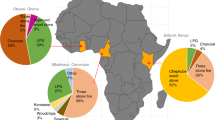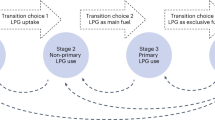Abstract
More than 70 million poor women in India have received liquefied petroleum gas (LPG) stoves within the first 35 months under a government programme, Pradhan Mantri Ujjwala Yojana (PMUY). Here, we analyse multi-year LPG sales data from a district in Karnataka to assess enrolment and consumption trends for both PMUY beneficiaries and general (non-PMUY) rural consumers. We find rapid growth in enrolments of LPG consumers, but this is not matched by an increase in LPG sales, suggesting that LPG access has not induced a full transition away from the use of polluting solid fuels. The number of LPG refills among PMUY beneficiaries is less than half that of rural general consumers. We also find no observable increase in LPG consumption among general rural consumers with years of experience. These results suggest that mid-course policy revisions to encourage regular LPG use are needed for both PMUY and general rural consumers.
This is a preview of subscription content, access via your institution
Access options
Access Nature and 54 other Nature Portfolio journals
Get Nature+, our best-value online-access subscription
$29.99 / 30 days
cancel any time
Subscribe to this journal
Receive 12 digital issues and online access to articles
$119.00 per year
only $9.92 per issue
Buy this article
- Purchase on Springer Link
- Instant access to full article PDF
Prices may be subject to local taxes which are calculated during checkout






Similar content being viewed by others
Data availability
The authors do not have ownership over the LPG sales data downloaded from the Indian Oil Corporation system. Researchers who seek access to the raw data to replicate this study or to perform other analyses should contact the Ministry of Petroleum and Natural Gas and/or IOCL.
Code availability
All the code and plots that were generated for this research, irrespective of whether they were used in the paper, are available via Figshare at https://doi.org/10.6084/m9.figshare.7961069 (Supplementary Code 1) and https://doi.org/10.6084/m9.figshare.7961066 (Supplementary Code 2). For state-wise data analysis for PMUY consumer use, refer to Supplementary Code 145. For Koppal sub-district LPG sales data-based analysis, refer to Supplementary Code 246.
References
Smith, K. R. in Making of New India: Transformation Under Modi Government (eds Debroy, B., Ganguly, A. & Desai, K.) 401–410 (Dr Syama Prasad Mookerjee Research Foundation and Wisdom Tree, 2018).
Anenberg, S. C. et al. Cleaner cooking solutions to achieve health, climate, and economic cobenefits. Environ. Sci. Technol. 47, 3944–3952 (2013).
International Energy Agency, International Renewable Energy Agency, United Nations Statistics Division, World Bank & World Health Organization. Tracking SDG7- The Energy Progress Report (International Bank for Reconstruction and Development/The World Bank, 2019).
Global Burden of Disease (GBD) Study 2017 (IHME, 2018).
Household Air Pollution and Noncommunicable Disease: Summary for Policy Makers (Health Effects Institute, 2018).
Bailis, R., Drigo, R., Ghilardi, A. & Masera, O. The carbon footprint of traditional woodfuels. Nat. Clim. Change 5, 266–272 (2015).
Dutta, S., Kooijman, A. & Cecelski, E. Energy Access and Gender: Getting the Right Balance (The World Bank, 2017).
Putti, V. R., Tsan, M., Mehta, S. & Kammila, S. The State of the Global Clean and Improved Cooking Sector (Energy Sector Management Assistance Program, Global Alliance for Clean Cookstoves, The World Bank, 2015).
Barua, S. K. & Agarwalla, S. K. Lighting up Lives through Cooking Gas and Transforming Society (Indian Institute of Management Ahmedabad, 2018).
Annual Report 2016–2017 (Ministry of Petroleum and Natural Gas, Government of India, 2017).
Shri Dharmendra Pradhan hands over 7Croreth LPG connection under PMUY; Milestone reached in just 34 months. Press Information Bureau (8 March 2019); pib.nic.in/Pressreleaseshare.aspx?PRID=1568341
Gould, C. F. & Urpelainen, J. LPG as a clean cooking fuel: adoption, use, and impact in rural india. Energy Policy 122, 395–408 (2018).
World Energy Outlook 2018 (International Energy Agency, 2018).
Jindal, A. in The Ujjwala Saga - Unending Happiness & Health 60–65 (Ministry of Petroleum and Natural Gas, Government of India, 2019).
Dabadge, A., Sreenivas, A. & Josey, A. What has the Pradhan Mantri Ujjwala Yojana achieved so far? Econ. Political Wkly 53, 69–75 (2018).
Johnson, M. A. & Chiang, R. A. Quantitative guidance for stove usage and performance to achieve health and environmental targets. Environ. Health Perspect. 123, 820–826 (2015).
Shankar, A. et al. Maximizing the benefits of improved cookstoves: moving from acquisition to correct and consistent use. Glob. Health Sci. Pract. 2, 268–274 (2014).
Kar, A. & Zerriffi, H. From cookstove acquisition to cooking transition: framing the behavioural aspects of cookstove interventions. Energy Res. Soc. Sci. 42, 22–33 (2018).
Ruiz-Mercado, I., Masera, O., Zamora, H. & Smith, K. R. Adoption and sustained use of improved cookstoves. Energy Policy 39, 7557–7566 (2011).
Kar, A., Singh, D., Pachauri, S., Bailis, R. & Zerriffi, H. in The Ujjwala Saga - Unending Happiness & Health 16–21 (Ministry of Petroleum and Natural Gas, Government of India, 2019).
Smith, K. R. & Dutta, K. “Cooking with Gas”. Energy Sustain. Dev. 15, 115–116 (2011).
Assessment Report: Primary Survey on Household Cooking Fuel Usage and Willingness to Convert to LPG (CRISIL, 2016).
Jain, A. et al. Access to Clean Cooking Energy and Electricity: Survey of States 2018 (Council on Energy, Environment and Water, 2018).
573 villages in Manipur identified for conversion to ‘Smokeless Villages’. The Assam Tribune http://www.assamtribune.com/scripts/detailsnew.asp?id=apr1518/oth051 (2018).
LPG Connections under PM Ujjwala Yojana is Providing Smoke Free Kitchens to Individuals (MyGov India, 2018).
Pradhan Mantri Ujjwala Yojana: A Giant Step Towards Better Life For All. Press Information Bureau http://pib.nic.in/newsite/printrelease.aspx?relid=148971 (2016).
Ruiz-Mercado, I. & Masera, O. Patterns of stove use in the context of fuel–device stacking: rationale and implications. EcoHealth 12, 42–56 (2015).
Giri, A. & Aadil, A. Pradhan Mantri Ujjwala Yojana: A demand-side diagnostic study of LPG refills (Policy Brief) (MicroSave, 2018).
Lewis, J. J. & Pattanayak, S. K. Who adopts improved fuels and cookstoves? A systematic review. Environ. Health Perspect. 120, 637–645 (2012).
Miller, G. & Mobarak, A. M. Gender Differences in Preferences, Intra-household Externalities, and Low Demand for Improved Cookstoves (National Bureau of Economic Research, 2013).
Rogers, E. M. Diffusion of Innovations (Free Press, 2003).
Venkatesh, V., Thong, J. Y. & Xu, X. Consumer acceptance and use of information technology: extending the unified theory of acceptance and use of technology. Manag. Inf. Syst. Q. 36, 157–178 (2012).
Singh, S. K. The Kaleidoscope of Cooking (Deutsche Gesellschaft für International Zusammenarbeit, 2014).
Rajakutty, S. & Kojima, M. Promoting Clean Household Fuels Among the Rural Poor: Evaluation of the Deepam Scheme in Andhra Pradesh 65 (The World Bank, 2002).
Khandelwal, M. et al. Why have improved cook-stove initiatives in india failed? World Dev. 92, 13–27 (2017).
Stanistreet, D. et al. The role of mixed methods in improved cookstove research. J. Health Commun. 20, 84–93 (2015).
Smith, K. R. & Jain, A. in Energizing India: Fuelling a Billion Lives (ed Mitra, S.) 48–72 (Rupa, 2019).
Ahmad, N., Sharma, S. & Singh, D. A. K. Pradhan Mantri Ujjwala Yojana (PMUY) step towards social inclusion in India. Int. J. Trend Res. Dev. 5, 4 (2018).
Anand, N. India’s GDP growth slows down to pre-Narendra Modi days. Quartz India https://qz.com/india/1294390/achhe-din-indias-gdp-growth-is-back-to-pre-narendra-modi-days/ (2018).
States of Growth 2.0: The Scorecard, and the Workout on How Each State Got to Where It Has (CRISIL, 2019).
Kumar, S. OMCs make provisions for PMUY losses. The Financial Express https://www.financialexpress.com/industry/omcs-make-provisions-for-pmuy-losses/1264022/ (2018).
WHO Guidelines for Indoor Air Quality: Household Fuel Combustion (World Health Organization, 2014).
Raihani, N. J. Nudge politics: efficacy and ethics. Front. Psychol. 4, 972 (2013).
Graham, E. A. et al. Laboratory demonstration and field verification of a wireless cookstove sensing system (WiCS) for determining cooking duration and fuel consumption. Energy Sustain. Dev. 23, 59–67 (2014).
Kar, A., Pachauri, S., Bailis, R. & Zerriffi, H. Using sales data to assess cooking gas adoption and the impact of India’s Ujjwala programme in rural Karnataka: Supplementary Code 1 (National) Figshare https://doi.org/10.6084/m9.figshare.7961069 (2019).
Kar, A., Pachauri, S., Bailis, R. & Zerriffi, H. Using sales data to assess cooking gas adoption and the impact of India’s Ujjwala programme in rural Karnataka: Supplementary Code 2 (Sub-district) Figshare https://doi.org/10.6084/m9.figshare.7961066 (2019).
Frequently Asked Questions (India Meteorological Department, 2018).
R Core Team R: A Language and Environment for Statistical Computing (R Foundation for Statistical Computing, 2018).
Report of the Comptroller and Auditor General of India on Implementation of PAHAL (DBTL) Scheme (Pratyaksh Hanstantrit Labh Yojana) (Comptroller and Auditor General of India, 2016).
Rousselet, G. A., Pernet, C. R. & Wilcox, R. R. Beyond differences in means: robust graphical methods to compare two groups in neuroscience. Eur. J. Neurosci. 46, 1738–1748 (2017).
olsrr: Tools for Building OLS Regression Models v.0.5.2 (Aravind Hebbali, 2018).
Venables, W. N. & Ripley, B. D. Modern Applied Statistics with S. 4th edn (Springer, 2002).
Kassambara, A. Stepwise Regression Essentials in R (STHDA, 2018); http://www.sthda.com/english/articles/37-model-selection-essentials-in-r/154-stepwise-regression-essentials-in-r/
Barnwal, P. Curbing Leakage in Public Programs with Direct Benefit Transfers (Michigan State University, 2016).
Acknowledgements
This article was developed under Assistance Agreement No. 83542102 awarded by the US Environmental Protection Agency (EPA) to R.B. (sub-award to H.Z.). The EPA has not formally reviewed it. The views expressed in this document are solely those of the authors and do not necessarily reflect those of the Agency. EPA does not endorse any products or commercial services mentioned in this publication. Part of the research was developed by A.K. during his time in the Young Scientists Summer Program at the International Institute for Applied Systems Analysis, Laxenburg, Austria, with financial support from the German National Member Organization. A.K. and H.Z. acknowledge support from the Wall Solutions Initiative provided by the Peter Wall Institute for Advanced Studies, the ‘Collaborative Research and Training Experience- Atmospheric Aerosol Program’ (CREATE-AAP) at the University of British Columbia and the Clean Cooking Alliance (United Nations Foundation). Access to data and interviews with officials from the Ministry of Petroleum and Natural Gas, Government of India, IOCL, Hindustan Petroleum Corporation Ltd and Bharat Petroleum Corporation Ltd was indispensable to this study. The authors are also indebted to the staff of the partner non-governmental organization SAMUHA for assistance with data collection. The authors also thank M. Brauer and S. Mehta for their feedback on the early drafts of the paper.
Author information
Authors and Affiliations
Contributions
A.K., S.P. and H.Z. designed the study. A.K. performed the data cleaning and coding. A.K., S.P., R.B. and H.Z. contributed to the writing of the paper.
Corresponding author
Ethics declarations
Competing interests
The authors declare no competing interests.
Additional information
Publisher’s note: Springer Nature remains neutral with regard to jurisdictional claims in published maps and institutional affiliations.
Supplementary information
Supplementary Information
Supplementary Figs. 1–13, Supplementary Tables 1–3 and Supplementary refs.
Rights and permissions
About this article
Cite this article
Kar, A., Pachauri, S., Bailis, R. et al. Using sales data to assess cooking gas adoption and the impact of India’s Ujjwala programme in rural Karnataka. Nat Energy 4, 806–814 (2019). https://doi.org/10.1038/s41560-019-0429-8
Received:
Accepted:
Published:
Issue Date:
DOI: https://doi.org/10.1038/s41560-019-0429-8
This article is cited by
-
Factors associated with the use of liquefied petroleum gas in Ghana vary at different stages of transition
Nature Energy (2024)
-
Evaluation of the preference for and viability of clean cookstove adoption in rural Tanzania
Energy, Sustainability and Society (2023)
-
Using high-frequency household surveys to describe energy use in rural North India during the COVID-19 pandemic
Nature Energy (2023)
-
Evidence of multidimensional gender inequality in energy services from a large-scale household survey in India
Nature Energy (2022)
-
Data are key to proving green-energy benefits
Nature (2022)



